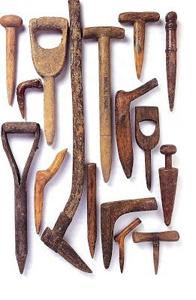The Antiques Addict: The Dirt on Early Garden Tools
By • May 4, 2016 2 4001

In the largely agrarian society of colonial America, what we think of as common garden tools were extremely valuable in planting and cultivating the beds and fields that fed whole families. As opposed to modern, mass-produced garden tools, the garden tools of old were custom made and held dear by the families who owned them. People’s livelihoods directly depended on their garden tools.
Until the 16th century, those tools were simple, basic and heavy, having evolved from agricultural implements used for hundreds of years. Colonists built raised, rectangular gardens right outside their homes. These cottage gardens were intensely cultivated and narrow enough to be tended from either side. The beds were filled with plants focused on function — herbs, vegetables, and flowers for dyes and fragrance.
Early New England settlers believed that gardens should be austere and utilitarian, and that flowers with no use were frivolous and extravagant, so each plant was valued for its usefulness, not its beauty. Although a few gardens were larger and better furnished than the others, the typical version was that of a small garden plot planted with leeks, onions, garlic, melons, English gourds, radishes, carrots, and cabbages, next to the humble colonial dwelling.
Urged by a higher spiritual need to remind themselves of all they left behind, 17th-century gardeners began to transplant wildflowers into their gardens. As the colonies became more prosperous in the 18th century, they separated flowers out of the vegetable gardens and into flower beds.
By the 18th century, Williamsburg was the capital of the wealthiest and most populous of the colonies, and the center of cultural life in Virginia. Gentry and artisans alike designed the grounds surrounding their homes as their personal stages on which to present themselves to passersby. Gardens evolved from necessity to expressions of beauty through art and nature, and sometimes as a display of private status. Most houses had a large front garden composed purely of flowers and/or lawn running down a path to their front gate, with the vegetables tucked away out of sight. The garden layout began to resemble the American landscape seen today.
In colonial capitals like Williamsburg and Annapolis, garden plot demarcations were actually required by colonial law to be built around each lot. Gardeners used line reels to demarcate a space within a garden or to set the dimensions of the garden itself. The end of the reel was inserted in the ground, the string on the top portion was pulled until the gardener had unwound sufficient string to mark his or her line on the land.
By the 1850s, more efficient production and transportation made tools more widely available to the masses. With their earthy patinas, organic materials and sculptural shapes, many of the garden tools of yore are popular with today’s collectors. An old, wooden pitchfork leaning in a corner, or a rake repurposed for holding clothes or wine glasses make interesting conversation pieces.
In America, rakes were very expensive and became an important possession of many 18th century families. Early wooden rakes with their warm patina can cost upwards of $150, and those pitchforks with animal antler tines can be priced in the hundreds. Those wooden line reels used to set old fence lines are difficult to find and are priced accordingly, at upward of $400, though more wrought iron models survived and are less expensive. The handy shield-shaped digging spade with a hand hewn wooden handle is a sought-after collector’s item and can be priced in the $150 range.
Dibbers, pencil-shaped tools for making planting holes, were usually made by the gardener himself out of branches of various diameters, depending on the sizes of the holes he needed. Some dibbers were made from old pipes or the salvageable parts of other tools.
Gathering baskets are one of most ubiquitous old implements. Historically, basket makers crafted their products from a variety of dried reeds and with a specific use in mind. There were wide-open baskets for gathering and carrying flowers and vegetables and large sturdy bins for storing root vegetables. Today, old baskets, especially those with original painted surfaces, can carry a price tag that may run into the thousands of dollars. They are especially popular because they can be easily recycled to fill many modern uses and can add a warm decorative touch to a room.
Garden tools have co-evolved with human society and have served mankind well. When you look into the history of some of the most common garden tools we use today — their images and descriptions in advertisements and old catalogs — you find that not much has changed in hundreds of years. What has changed, though, is the value placed on those implements.
Michelle Galler is an antiques dealer, design consultant and realtor based in Georgetown. Her shop is in Rare Finds, in Washington, Virginia. Contact her at antiques.and.whimsies@gmail.com.


Wow. This is a great article. It has more useful information for garden tools. I like it. I learned a lot from it. It will help me. Thanks for sharing.
Lots of useful information for garden tools. Thanks for sharing with us.